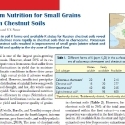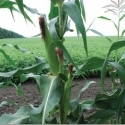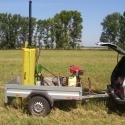20 Jan 2016
Nutrient Management in Spring Rapeseed-based Systems in the Southern Ural Region
G.B. Kirillova and G.M. Yusupova

Rapeseed’s many uses in products destined for food, oil, forage, and biodiesel have rapidly driven up its production in Russia. Rapeseed crop area has increased by 1.5 times from 2010 to 2013 when it reached its record 1.3 million ha (ROSSTAT, 2014). Spring-sown varieties accounted for 85% of rapeseed’s area in 2013, nationally. Our example below from the Russian republic of Bashkortostan, located in the southern Ural region north of Kazakhstan, has shown a similar increase in area seeded to spring rapeseed—reaching 39,000 ha in 2012.
In recent decades, fertilizer use throughout Russia has clearly been low and during the last four years has leveled off at only 39 kg N+P2O5+K2O/ha sown area. Bashkortostan, however, only consumes 50% of this already low national average. This inadequate supply of nutrients can be easily connected to the region’s stagnantly low rapeseed yields.
Research in Bashkortostan has been studying the effect of different nutrient management options on rapeseed yield and quality. A three-year field experiment was set up to examine a typical cereal-fodder crop rotation of fallowed green manure (GM), winter wheat, spring wheat, spring rapeseed (cv. Yubileyniy), and silage maize.
The site’s soil was fi ne-textured and the surface layer had medium available P and ‘increased’ (or elevated) available K (40 to 41 ppm P and 95 to 100 ppm K, respectively)—both extracted with 0.5 M acetic acid solution. The site was located on a typical leached grassland soil classified as a Luvic Chernozem. The soil has relatively high organic matter content (6.8 to 7.2%) and was slightly acidic (pHKCl = 5.2).
The two nutrient management approaches were 1) application of fertilizers and 2) combined application of fertilizers and GM from field pea (Table 1). All experiments included a zero-fertilizer (control) treatment and a GM treatment. Treatments 6, 7 and 8 tested the effect of fertilizer application plus GM (third year tested the residual effect of GM). Nutrient application rates were based upon a spring rapeseed yield goal of 2.5 t/ha. Nutrient rates in treatments 2 and 6, 3 and 7, and 4 and 8 were also designed according to a negative (-20 kg P2O5/ha), zero, and positive (20 kg P2O5/ha) P balance. Nitrogen and K rates were based on a zero N balance and a negative K balance (-25 kg K2O/ha).
Nutrient rates (F) were calculated using a balance method based on an estimated partial nutrient balance (PNB) according to the following formula (Zhukov, 1977):
F = (R ÷ PNB) x 100, where R = nutrient removal (N, P2O5 and K2O) by the targeted seed yield.
PNBN was estimated at 100%; PNBP was 150, 100, and 70% for treatments 2 and 6, 3 and 7, and 4 and 8, respectively (Table 1); and PNBK was 150%.
Results
Rapeseed yield fluctuated during the three years and was strongly dependent on the weather (Table 1). Weather conditions were quite favorable in 2011 and 2013 as temperatures were close to the long-term average and precipitation was higher than the long-term average. The 2012 season could be characterized as dry and hot with temperatures above the long-term average and monthly rainfall was severely deficient during April, May and July, but excessive in August. In 2012, seed yield was as low as 1.10 to 1.16 t/ha, or 44 to 46% of the yield goal. The best crop year was 2011, which achieved yields of 2.8 to 3.12 t/ha, or 112 to 125% of the yield goal.
Fertilizer application significantly increased seed yield in all years. The highest rates (N125P80K50 and N115P80K50) resulted in a 0.52 to 0.56 t/ha yield increase (33 to 35%) over the three years. The highest average yield of 2.14 t/ha (GM + N115P80K50) was close to the yield goal, reaching 85% of the target.
In 2012 and 2013, all nutrient management systems achieved a similar relative effect on seed yield. However, the best growing season of 2011 is distinguished by its response to increasing P fertilizer rates up to 80 kg P2O5/ha (the preplanned positive P balance), which increased seed yield to more than 3.0 t/ha. Incorporation of field pea GM into the crop rotation seemed to allow for a N fertilizer rate reduction of 8% fertilizer rate with or without GM application.
All nutrient management systems increased seed N and K concentrations each season (Table 2). Seed N and K concentrations respectively increased by 0.59 to 0.64% and 0.11 to 0.15% due to fertilizer application (three-year average) and reached 3.33 to 3.38% and 0.96 to 1.00% on a dry matter basis. Nutrient management had no significant effect on seed P concentrations in any season.
Nutrient management also impacted crude protein concentrations in all three seasons (Table 2). Crude protein increased by 3.2 to 3.6% and reached a maximum of 19.8% (three-year average). Increasing rates of P fertilizer had no affect on crude protein concentration. The highest concentrations of N, P, K, and crude protein were observed in driest and hottest year of 2012.
These results highlight the variable nature of growing season climate in Bashkortostan. Periodic drought can have a significant impact on the yield and quality of rapeseed. Factor analysis of seed yield variability showed that weather and nutrient management accounted for 91% and 7% of the variation, respectively. Nitrogen concentration in seeds was equally dependent on weather and nutrient management. Weather conditions accounted for most of the variation in seed P concentration. Nutrient management and weather accounted for 55% and 39% of the variation in seed K concentration, respectively.
Three-year averages for the apparent nutrient balance are presented in Table 3. A positive N balance and a negative K balance were observed in all treatments supplying fertilizer nutrients. The P balance was positive for treatments receiving 60 to 80 kg P2O5/ha and were negative under lower rates of fertilizer P. The PNBN ranged from 70 to 82%, which is much lower that the 100% value used during the nutrient rate calculations. This difference is related to the actual seed yields obtained in this study, which were lower than the target yield.
Crop demand for nutrients may be estimated based on nutrient removal in the harvested portion of crops and the corresponding amount of straw. In treatments supplying nutrients from fertilizer, the removal of N, P2O5 and K2O (kg/t of seed) increased by 10 to 11, 2, and 7 to 8 kg and reached 52, 25, and 43 kg/t, respectively. Nitrogen and P removal per t of harvested seeds plus straw was close to coefficients normally used for the agroecological zone; however, the removal of K was higher in this study. Thus, removal values need to be updated to properly guide K application rates to meet the yield goals of spring rapeseed.
Three-year averages for agronomic efficiency (AE) of NPK and the contribution of fertilizers to seed yield are also given in Table 3. The AE of NPK in fertilizer treatments ranged from 1.74 to 2.04 kg seed/kg N+P2O5+K2O and increased when higher nutrient rates were applied. The contribution of fertilizers to seed yield was between 21 to 26%. All these efficiency parameters tended to be higher under a nutrient management system that included both fertilizers and GM application.
Site-specific nutrient management in the Republic of Bashkortostan supported a yield of spring rapeseed that ranged from 2.00 to 2.14 t/ha, or 80 to 86% of the yield goal. The average crude protein concentration in seeds was also increased to up to 19.8% with balanced fertilization indicating a significant gain in quality.
Dr. Kirillova is Professor (e-mail: kgbufa@mail.ru) and Ms. Yusupova (e-mail: gulnaz-yusupova-93@mail.ru) is a M.Sc. Student, Department of Soil Science, Agricultural Chemistry and Soil Management, Bashkir State Agrarian University, Ufa, Republic of Bashkortostan, Russia. The authors acknowledge Dr. V. Nosov, IPNI Director, Southern and Eastern Russia, for his help during the preparation of this article.
References
ROSSTAT, 2014. http://www.gks.ru
Zhukov, Yu. P. 1977. In Results obtained in the Geographical Network of Field Experiments with Fertilizers and directions to improve fertilizer use efficiency in Non-chernozem zone. Moscow, 23-24. (In Russian).




